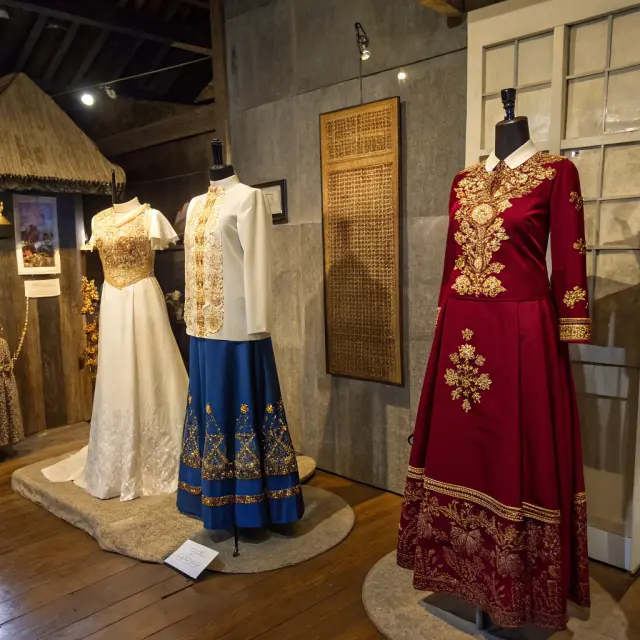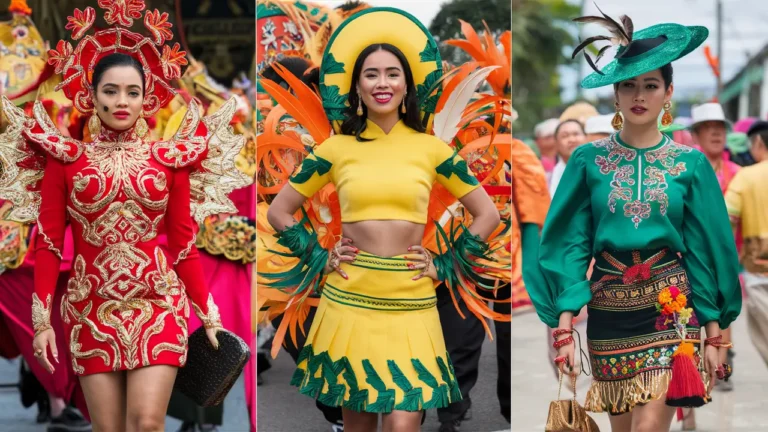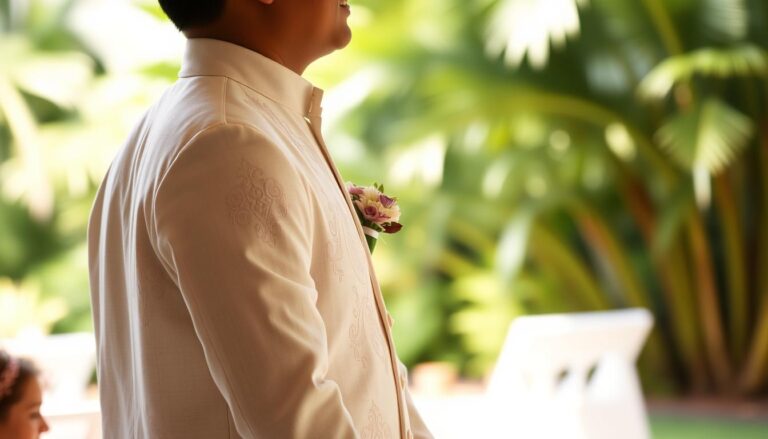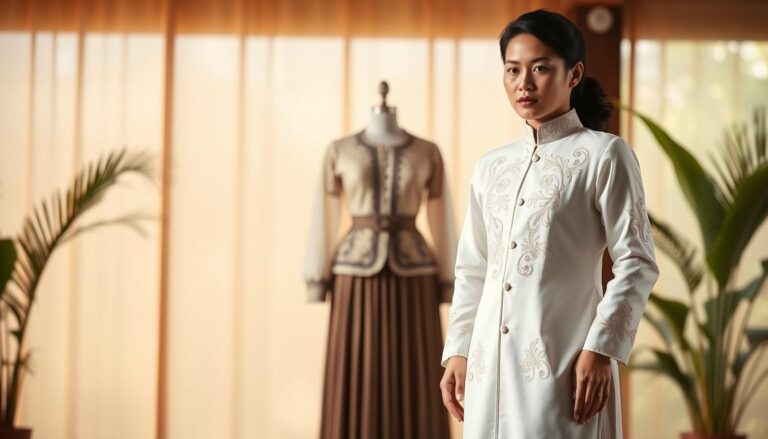Understanding Filipiniana Fabrics: A Comprehensive Guide

The vibrant threads of Philippine culture are woven into every strand of its iconic textiles. For centuries, natural fibers like pineapple leaf-based piña, silky jusi, and lustrous silk have defined the elegance of traditional attire. These materials aren’t just cloth—they’re living records of history, craftsmanship, and identity.
From formal Barong Tagalog shirts to intricate Maria Clara gowns, these fabrics elevate clothing into cultural statements. While modern synthetic alternatives exist, natural fibers remain prized for their breathability and connection to heritage. Each piece tells a story of meticulous hand-weaving techniques passed through generations.
The creation process itself is an artform. Skilled artisans extract pineapple fibers by hand, spin them into delicate threads, and weave patterns reflecting regional traditions. This labor-intensive approach ensures every garment carries unmatched authenticity.
In this guide, we’ll explore how these textiles evolved through Spanish colonial influences and indigenous practices. You’ll discover the unique qualities of materials like Abel Iloko and T’nalak, along with care tips to preserve their beauty. Prepare to uncover the craftsmanship behind attire that continues to shape Philippine cultural pride.
Key Takeaways
- Natural fibers like piña and jusi define the elegance of traditional Philippine clothing
- Handcrafted production methods preserve centuries-old cultural heritage
- Iconic garments showcase intricate weaving patterns and embroidery techniques
- Historical influences blend indigenous and colonial textile traditions
- Proper care maintains the quality of delicate natural fabrics
- Modern designs continue evolving while honoring cultural roots
Introduction to Filipiniana Fabrics: History and Cultural Significance
Philippine clothing tells a story of resilience through its stitches. Before Spanish ships arrived, indigenous communities wore simple wrap-around skirts called tapis, crafted from bark or woven fibers. These early garments prioritized function over form, reflecting practical needs in tropical climates.
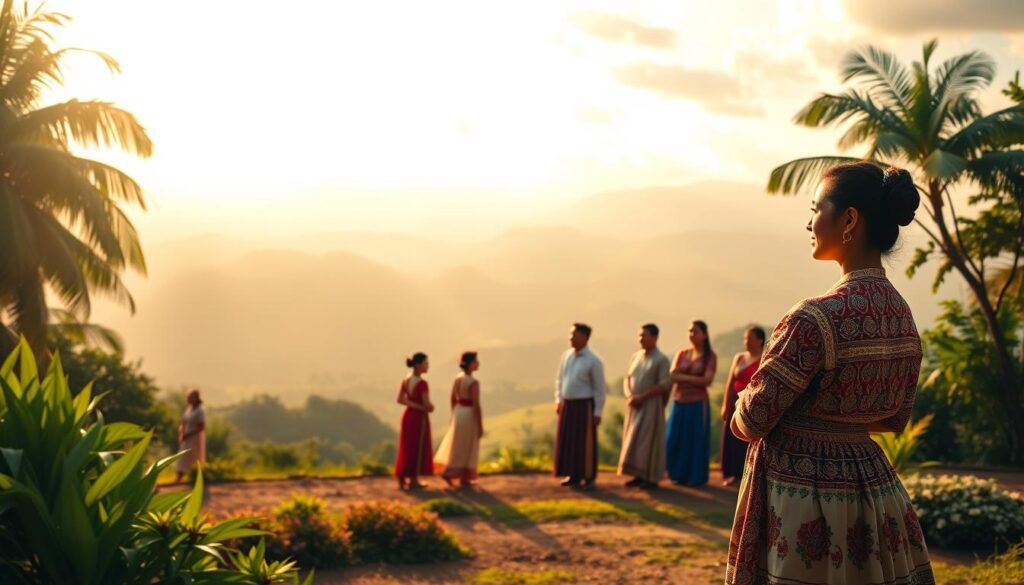
The Evolution of Cultural Attire in the Philippines
Colonial rule transformed local fashion dramatically. The baro’t saya emerged—a two-piece ensemble blending Spanish modesty with native flair. Women layered delicate pañuelo scarves over embroidered blouses, while men adopted the lightweight barong tagalog as formal wear.
By the 1890s, this style evolved into the Maria Clara gown, named after a literary symbol of Filipino virtue. Its flowing silhouette and intricate embroidery became synonymous with national pride. The 1930s introduced the terno, featuring bold butterfly sleeves that remain iconic today.
Key Historical Milestones and Influences
Three major events reshaped traditional cloth choices. First, Spanish friars mandated translucent pineapple fiber fabrics for the barong tagalog—a rule Filipinos subverted through elaborate embroidery. Second, 1910’s Traje de Mestiza formalized eveningwear styles using Chinese silks. Finally, post-WWII designers reimagined these designs for global runways.
Regional variations reveal cultural depth. The Visayan kimona and Ilocano abel textiles demonstrate how communities adapted central styles. Modern interpretations balance heritage with contemporary style, proving traditional garments remain living art forms rather than museum pieces.
Understanding Filipiniana Fabrics: Materials and Production Techniques
The hands of skilled artisans transform humble plants into luxurious cloth. Three materials dominate traditional Philippine garments: piña from pineapple leaves, jusi from banana fibers, and imported silk. Each requires specialized techniques perfected over generations.
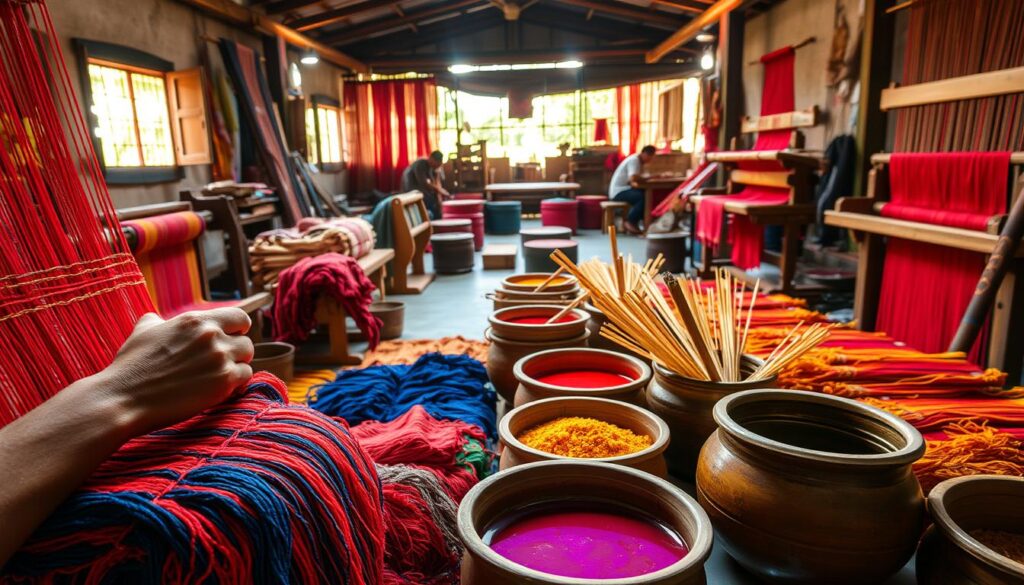
Natural Fabrics: Piña, Jusi, and Silk
Creating piña begins with scraping pineapple leaves to extract hair-thin fibers. Workers in Aklan province knot these strands by hand before weaving them into translucent fabric. The 45-day process yields cloth so delicate it tears like tissue paper.
Jusi fabric offers a more affordable alternative. Artisans twist abaca fibers with silk threads to create lightweight material ideal for tropical weather. Though less fragile than piña, it still demands careful handling during embroidery.
Silk entered Philippine fashion through Chinese traders. When blended with piña, it adds strength to formal wear like the terno gown. These natural materials remain preferred for high-end attire despite their labor costs.
Synthetic Alternatives and Modern Weaves
Modern designers often choose organza and chiffon for everyday outfits. These synthetic blends mimic piña’s sheen while resisting wrinkles. Polyester versions cost 80% less than handwoven piña, making traditional styles accessible.
New production methods address durability concerns. Machine-woven jusi mixes cotton with rayon, creating fabric that holds bold embroidery better. However, purists argue synthetic blends lack the cultural resonance of plant-based textiles.
Contemporary workshops balance innovation with tradition. Some use pineapple-polyester blends to preserve weaving techniques while reducing prices. Others dye organza with natural pigments to honor ancestral color palettes.
Traditional Designs vs. Modern Interpretations
Evolving styles carry cultural stories from loom to runway. Classic Philippine garments maintain their DNA while adapting to new aesthetics. Designers walk a tightrope between preserving heritage and meeting modern tastes.
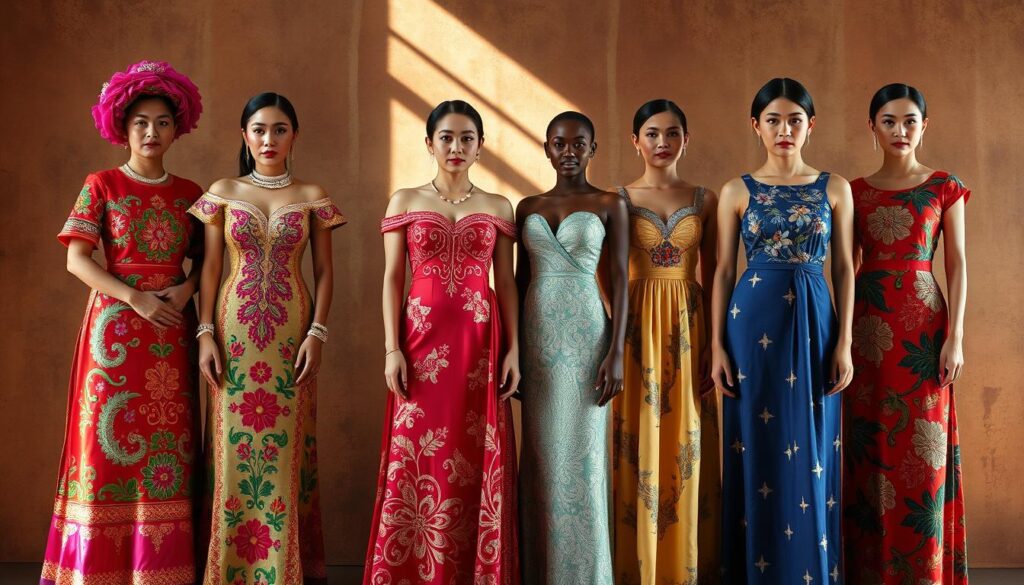
Classic Styles: Barong Tagalog, Maria Clara, and More
The Maria Clara gown remains the gold standard for formal events. Its structured baro blouse pairs with flowing saya skirts, often accented by embroidered shawls. Men’s Barong Tagalog shirts feature geometric patterns woven into translucent piña cloth.
Traditional dresses prioritize modesty with floor-length silhouettes. Butterfly sleeves and hand-stitched floral motifs dominate these timeless pieces. “You’re not just wearing cloth – you’re draping history,” says Manila-based designer Lito Perez.
Contemporary Adaptations and Fashion Trends
Modern outfits rework classic elements for daily wear. Crop tops now showcase jusi fabric, while pencil skirts replace voluminous layers. Designers fuse indigenous patterns with asymmetrical cuts for cocktail dresses.
Three key updates define today’s styles:
- Shorter hemlines for mobility
- Minimalist necklines replacing elaborate collars
- Mix-and-match separates instead of full gowns
Events like TernoCon prove tradition thrives through innovation. Emerging labels pair pineapple fiber with denim jackets, creating streetwear that nods to ancestral craftsmanship.
Practical Applications: Filipiniana Fabrics in Attire and Celebrations
Cultural pride shines through fabric choices at life’s milestones. Designers and wearers alike use traditional textiles to bridge generations, transforming ceremonies into living heritage exhibits.
Creating Timeless Wedding Moments
Modern weddings showcase pineapple silk gowns with dramatic butterfly sleeves. Brides often pair piña overlays with European lace for cross-cultural elegance. Smaller ceremonies feature jusi wrap dresses that transition seamlessly from vows to receptions.
These fabrics adapt to any occasion. Aklan weavers recently crafted a 12-foot piña train for a Manila cathedral ceremony. Meanwhile, Cebu designers create cocktail-length abel skirts for beachfront vows.
| Event Type | Fabric Choice | Styling Tip |
|---|---|---|
| Grand Ballroom | Piña-Silk Blend | Pair with cathedral sleeves |
| Garden Party | Jusi-Chiffon Mix | Opt for cap sleeves |
| Intimate Gathering | Abel Cotton | Choose flutter sleeves |
Everyday Cultural Expressions
Fashion-forward people now wear heritage textiles daily. Office workers pair jusi blouses with pencil skirts, while students rock pineapple-fiber crop tops. Bench Pinoy Lab’s streetwear line mixes abel patterns with denim jackets.
Three ways to make a statement:
- Choose tops with subtle sleeve accents
- Mix traditional weaves with modern cuts
- Use neutral tones for workplace versatility
Designer Rajo Laurel notes: “Our textiles deserve spotlighting beyond festivals – they’re conversation starters in any setting.” This approach keeps craftsmanship relevant while honoring roots.
Styling, Maintenance, and Care for Filipiniana Fabrics
Mastering the art of presentation and preservation keeps cultural garments looking their best. Thoughtful styling choices highlight craftsmanship, while proper care protects delicate materials for future generations.
Accessorizing and Enhancing Traditional Outfits
Choose jewelry that accentuates key features without overwhelming the outfit. Pearl necklaces draw attention to the shoulders in white ensembles, while gold cuffs complement bold red hues. For waist-defining looks, pair embroidered belts with flowing skirts.
Match hairstyles to your outfit’s neckline. Sleek buns suit high-collared baro blouses, while loose waves balance square cuts. Makeup should harmonize with fabric tones—nude lips for ivory cotton, berry shades for jewel-toned silk.
Cleaning, Storing, and Preservation Best Practices
Hand-wash delicate pieces in cold water using mild soap. Gently squeeze—never wring—to protect intricate weaving. Lay flat on mesh racks to air-dry, avoiding direct sunlight that fades colors.
Store garments in breathable cotton bags with silica packets. Fold along natural creases to prevent stress on embroidery. For heirloom pieces, professional cleaning preserves structural integrity while maintaining their fashion appeal.
Rotate outfits seasonally to prevent fabric fatigue. Insert acid-free tissue in sleeves to maintain shape. With proper care, these textiles can showcase their artistry for decades while staying relevant in modern wardrobes.
Conclusion
From loom to wardrobe, Philippine textiles weave a narrative of cultural pride and contemporary style. These materials carry centuries of craftsmanship in every thread, blending ancestral techniques with modern design innovations. The unique look achieved through pineapple leaf fibers and meticulous weaving offers women across the country a powerful way to honor their roots while making fashion statements.
Whether choosing a formal gown or casual separates, each piece reflects careful material selection and artisanal touch. Lightweight pineapple blends and durable jusi fabrics prove tradition adapts beautifully to today’s lifestyles. Regional patterns transformed into office wear or streetwear demonstrate how heritage thrives through reinvention.
Embracing these textiles means celebrating identity in tangible ways. Every draped sleeve and embroidered detail becomes a conversation about cultural continuity. As designers reimagine classic silhouettes, they create fresh opportunities to showcase national pride. Let your clothing choices tell stories of resilience, artistry, and belonging—thread by meaningful thread.

